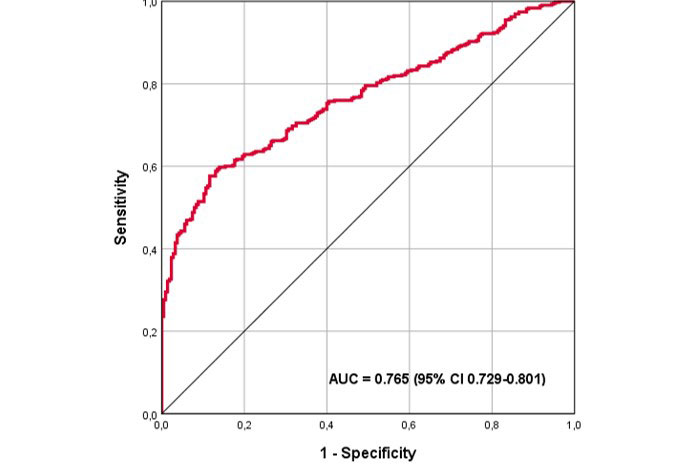Session Information
Date: Sunday, November 13, 2022
Title: Osteoporosis and Metabolic Bone Disease – Basic and Clinical Science Poster
Session Type: Poster Session C
Session Time: 1:00PM-3:00PM
Background/Purpose: Chronic non-bacterial osteomyelitis (CNO) in adults exhibits as sterile osteitis and consequent disrupted bone metabolism favoring bone formation of the sternocostoclavicular region (SCCH). Diagnosis is challenging due to unspecific presentation and lack of biomarkers. Systemic inflammatory-based scores (SIBS) emerge as novel diagnostics that also correlate with disease activity in other inflammatory musculoskeletal diseases. We assess their clinical validity in CNO/SCCH for the first time.
Methods: Cross-sectional study in adult CNO/SCCH patients and suspected CNO/SCCH controls not using immunomodulatory treatment (exempting NSAIDs) or bisphosphonates. C-reactive protein (CRP), erythrocyte sedimentation rate (ESR), SIBS (neutrophil to lymphocyte ratio (NLR), and systemic immune-inflammation index (SII; product of platelet count and NLR)), and bone turnover markers (BTMs; N-terminal propeptide of type 1 procollagen (P1NP) and cross-linked carboxy-terminal telopeptide of type 1 collagen (CTx)) were compared between patients and controls, and between patients with moderately and severely increased isotope uptake on nuclear imaging. Receiver operating characteristics (ROC) analysis was performed for the optimal predictor set as revealed with backward stepwise regression.
Results: 172 and 72 patients and 82 and 36 controls were included for biochemical and SIBS analysis respectively. ESR and CRP were significantly higher in CNO/SCCH (median 12 vs. 6, p< 0.000 and median 3.7 vs. 1.0 (p< 0.000), as were platelet count (285 vs. 249, p=0.003), neutrophils (5 vs. 4, p=0.006) , NLR (2.1 vs 1.7, p=0.012) and corresponding SII (659 vs. 472, p=0.009). Patients had higher P1NP/CTx ratio (197 vs. 164, p=0.012). ESR and neutrophils were significantly higher in patients with severely increased isotope uptake (20 vs. 13, p=0.009, 5 vs. 4, p=0.05, respectively).
ESR, neutrophils and P1NP/CTx emerged as optimal (independent) predictors of CNO/SCCH, with an area under the curve (AUC) of 0.765 (95% CI 0.729-0.801) (see figure 1).
Conclusion: In the present study, ESR, CRP, platelet count, neutrophils and neutrophil-derived SIBS were increased in CNO/SCCH as compared to mimicking controls, as was the ratio between bone formation and resorption reflected by P1NP/CTx. ESR, neutrophils and P1NP/CTx have the best combined diagnostic value. Given the current lack of biomarkers to diagnose and monitor CNO/SCCH, our findings form a promising new area of research into the utility of neutrophil-derived SIBS and BTMs in diagnosis, disease course and treatment response.
To cite this abstract in AMA style:
Leerling A, Faber J, Appelman-Dijkstra N, Dekkers O, Winter E. Systemic Inflammatory-based Scores and Bone Turnover Ratio as Novel Diagnostic Tools for Chronic Nonbacterial Osteomyelitis (CNO) of the Sternocostoclavicular Region in Adults [abstract]. Arthritis Rheumatol. 2022; 74 (suppl 9). https://acrabstracts.org/abstract/systemic-inflammatory-based-scores-and-bone-turnover-ratio-as-novel-diagnostic-tools-for-chronic-nonbacterial-osteomyelitis-cno-of-the-sternocostoclavicular-region-in-adults/. Accessed .« Back to ACR Convergence 2022
ACR Meeting Abstracts - https://acrabstracts.org/abstract/systemic-inflammatory-based-scores-and-bone-turnover-ratio-as-novel-diagnostic-tools-for-chronic-nonbacterial-osteomyelitis-cno-of-the-sternocostoclavicular-region-in-adults/

